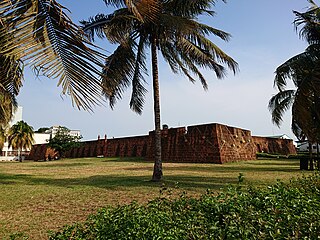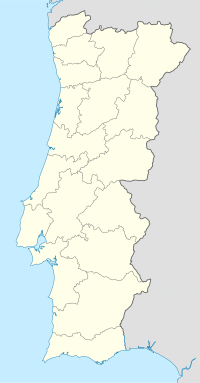
Chaves is a city and a municipality in the north of Portugal. It is 10 km south of the Spanish border and 22 km south of Verín (Spain). The population of the entire municipality in 2011 was 41,243, in an area of 591.23 km2. The municipality is the second most populous of the district of Vila Real. With origins in the Roman civitas Aquæ Flaviæ, Chaves has developed into a regional center. The urban area or city proper has 17,535 residents (2001).

Praia da Vitória is a municipality in the Portuguese archipelago of the Azores. With a population of 21,035, the second largest administrative authority on the island of Terceira, it covers an area of 161.27 square kilometres (62.27 sq mi), that extends from the northern coast halfway into the interior.

Vila do Porto is the single municipality, the name of the main town and one of the civil parishes on the island of Santa Maria, in the Portuguese archipelago of Azores. Its nearest neighbor, administratively, is the municipality of Povoação on the southern coast of São Miguel, and it is physically southwest of the islets of the Formigas. The population in 2021 was 5,408, in an area of 96.89 km2 (37.41 sq mi).

Angra do Heroísmo, or simply Angra, is a city and municipality on Terceira Island, Portugal, and one of the three capital cities of the Azores. Founded in 1478, Angra was historically the most important city in the Azores, as seat of the Bishop of the Azores, government entities, and having previously served as the capital city of Portugal during the Liberal Wars. The population in 2011 was 35,402, in an area of 239.00 km2. It was classified as a World Heritage site by UNESCO in 1983.

Elvas is a Portuguese municipality, former episcopal city and frontier fortress of easternmost central Portugal, located in the district of Portalegre in Alentejo. It is situated about 200 kilometres (120 mi) east of Lisbon, and about 8 kilometres (5.0 mi) west of the Spanish fortress of Badajoz, by the Madrid-Badajoz-Lisbon railway. The municipality population as of 2011 was 23,078, in an area of 631.29 square kilometres (243.74 sq mi). The city itself had a population of 16,640 as of 2011.

The Battle of the Lines of Elvas, was fought on 14 January 1659, in Elvas, between Portugal and Spain during the Portuguese Restoration War. It ended in a decisive Portuguese victory.

Fafe is a municipality in the northern Portuguese district of Braga. The population in 2021 was 48,502, in an area of approximately 219.08 square kilometres (84.59 sq mi). The city itself had a population of 14,144 in 2001. The present mayor is Antero Barbosa, elected by the Socialist Party. The municipal holiday is May 16.

The Castle of Elvas is a medieval military fortification in Portugal, in the civil parish of Alcáçova, municipality of Elvas, part of a first line of defense in the Portuguese Alentejo, in conjunction with the military forts of Ouguela, Campo Maior, Olivença and Juromenha.

The Fort of Santa Catarina is a medieval fort situated in the civil parish of Portimão, in the municipality of Portimão in Portuguese Algarve. The structure was considered one of the last Philippine military projects in the Algarve, erected to defend the peninsula from pirates and privateers, as well as military invasions. Its construction is one of the better examples that work of Alexandre Massai, a military engineer who toured the Algarve to reinforce numerous military fortifications along the coast.

The fourth siege of Badajoz took place from July to October 1658 during the Portuguese Restoration War. It was an attempt by a huge Portuguese army under the command of Joanne Mendes de Vasconcelos, governor of Alentejo, to capture the Spanish city of Badajoz, which was the headquarters of the Spanish Army of Extremadura. The fortifications of Badajoz were essentially medieval and considered vulnerable by the Portuguese, and had already been attacked by them three times during this war.

The Nossa Senhora da Graça Fort, officially Conde de Lippe Fort and known historically as La Lippe, is a fort in the village of Alcáçova, about 1 kilometre (0.62 mi) north of the town of Elvas in the Portalegre District of Portugal.

The Fort Nossa Senhora do Rosário, better known as Forte São Francisco of Chaves is located in the city of Chaves, in the Parish of Santa Maria Maior, District of Vila Real, in Portugal.

The Fort Nossa Senhora da Conceição of Lourenço Marques, nowadays known as the Maputo Fortress is located at Praça 25 de Junho and represents one of the main historical monuments of the city of Maputo, former Lourenço Marques, in Mozambique.

Fort São João Baptista, also known as Fort of Nossa Senhora da Assunção, is located at the mouth of the river Ave, in the town of Vila do Conde, district of Porto, in Portugal.
The Fort Santiago da Barra de Viana do Castelo also referred to as Castle Santiago da Barra and Castle São Tiago Maior da Barra is located in the parish of Santa Maria Maior, Monserrate, and Meadela, in the city of Viana do Castelo in Portugal.

The Fort Santa Maria da Arrábida also referred to as Fort Nossa Senhora da Arrábida, Fort of Arrábida and Fort of Portinho da Arrábida, is located at the foot of the southern slope of the mountain range of the same name, in a dominant position to southwest of Portinho da Arrábida, on the northern bank of the Sado River, in the Municipality and District of Setúbal, in Portugal.
Miguel de Arruda was a Portuguese mestre de obras, architect and military engineer. He was the son of Francisco de Arruda and nephew of Diogo de Arruda, both famed Portuguese architects.

























